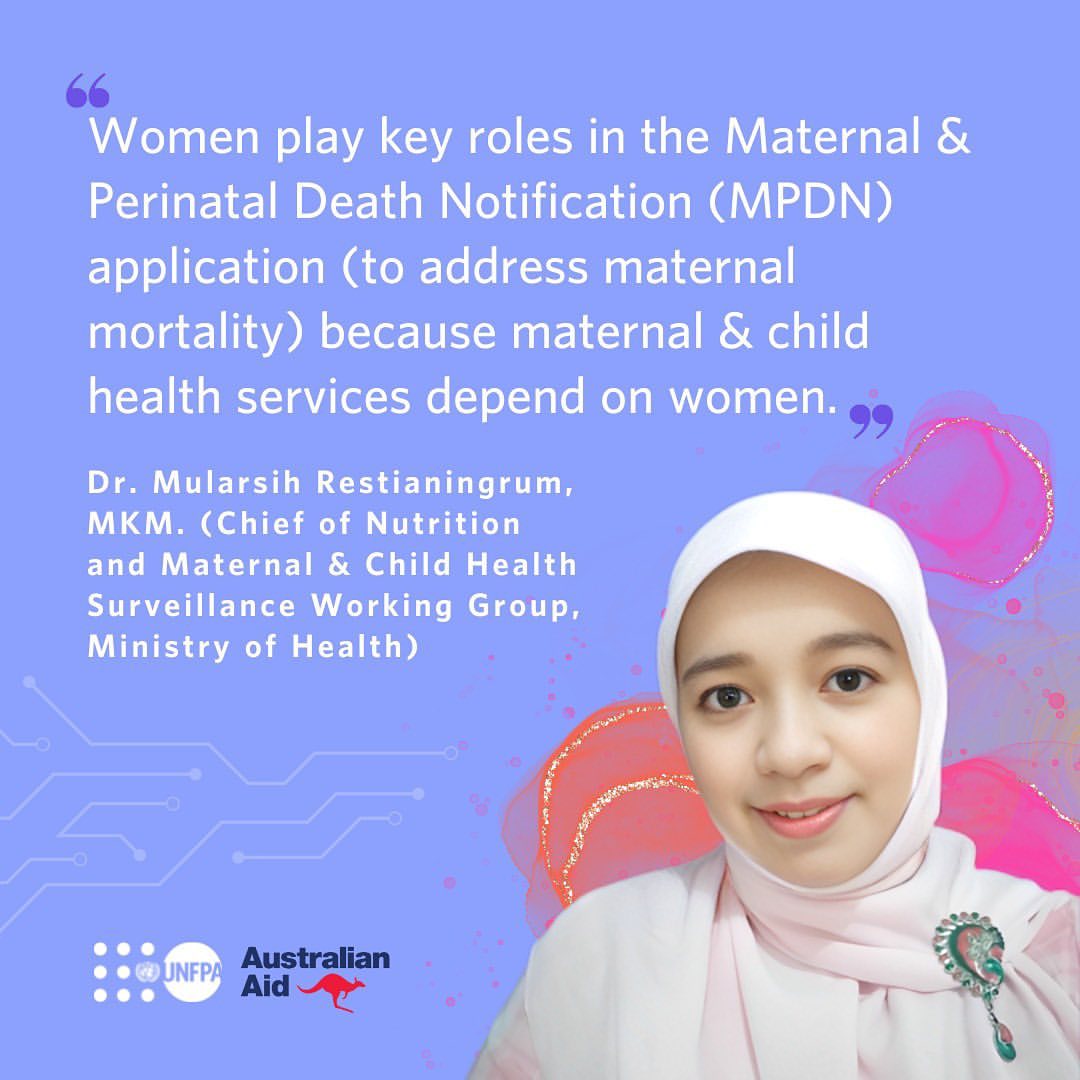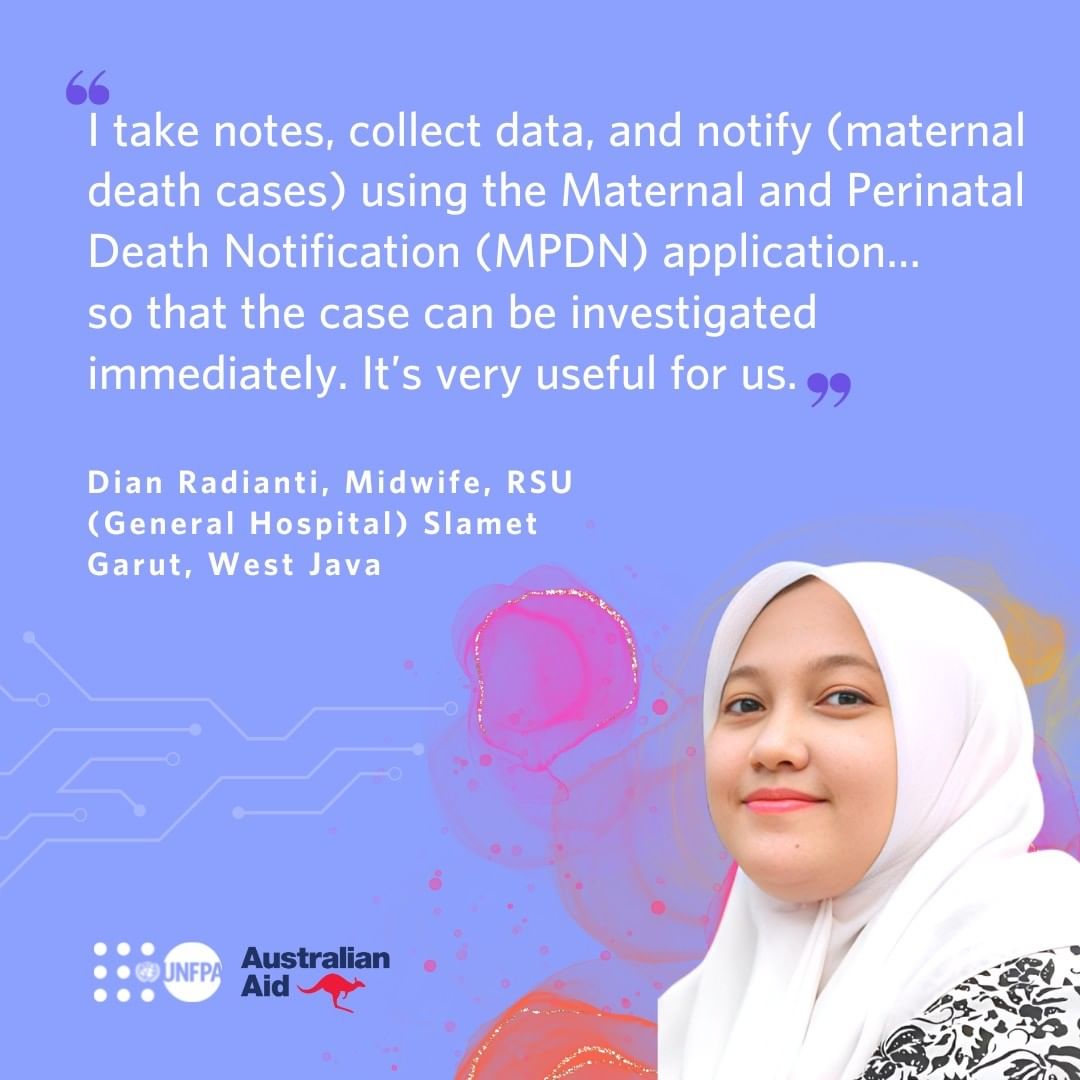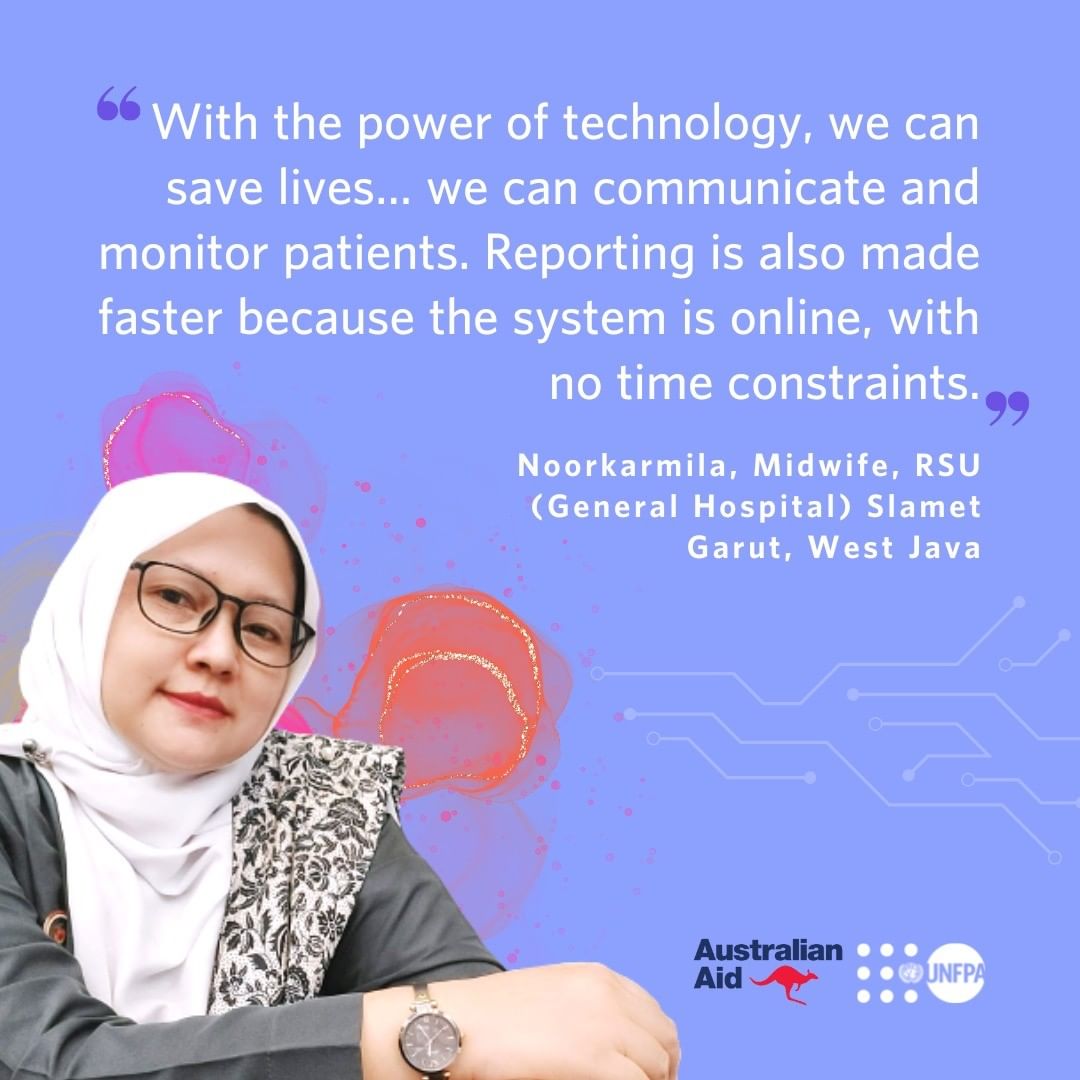With 189 maternal deaths per 100,000 live births (2020 Population Census), Indonesia has a substantially higher Maternal Mortality Ratio (MMR) compared to other countries in Southeast Asia.
With support from the Australian Department of Foreign Affairs and Trade (DFAT), UNFPA Indonesia works with the Ministry of Health in improving maternal health and reducing maternal mortality in Indonesia by strengthening the maternal and perinatal audit, surveillance and response (MPDSR) systems and implementation. With robust sexual and reproductive health data recording and analysis, we can ensure service monitoring, resource allocation, quality improvement, and decision making that accelerates MMR reduction in Indonesia.
Continuous improvement to address underreporting

Dr. Mularsih Restianingrum, MKM, Head of Nutrition and Maternal & Child Health Surveillance Working Group at the Ministry of Health, serves as the focal point of the Maternal and Perinatal Mortality Audit, Surveillance, and Response (MPDSR/AMPSR - Audit Maternal Perinatal, Surveilans dan Respons) working group that focuses on developing guidelines and policies, monitoring and evaluation, and meeting indicators of MMR reduction.
“We have implemented the audit of maternal and perinatal mortality since the 1990s. When maternal and infant deaths happen, we would summon midwives and community health centers (puskesmas)... put them on trials,” Dr. Mularsih, also known as Ningrum, elaborated.
With support from UNFPA and DFAT, the Ministry of Health made critical changes in the policy.
“In 2018, we changed the policy to ‘no naming, no shaming, no blaming’. And then we revised it again in 2020, from AMP to AMPSR, adding the surveillance and response elements,” she continued.
Ningrum hopes the revisions can address the underreporting of maternal and infant mortality cases and improve the quality of care through the response mechanisms. “Now AMPSR engages all stakeholders. Back then, only district/municipal health offices did the assessment. But now, healthcare facilities like hospitals as well as the provincial and national health offices also do it… at every level and administration,” Ningrum added. The assessment is a critical part of AMPSR as it helps to identify causes of deaths and recommend follow up actions to respond to the cases.
According to Ningrum, in many cases maternal death happens when women are not prepared to get married and get pregnant. However, the quality of healthcare for pregnant women plays a key role in preventing maternal deaths.
Improving data collection at hospitals
To collect and store maternal and infant mortality data, the Ministry of Health has developed the Maternal and Perinatal Death Notification (MPDN) application. “MPDN is an application for reporting maternal and infant mortality, by name and by address… We are now adding new features to the MPDN application so that we can include analysis of cases at district/municipal and hospital levels,” Ningrum explained.
“To conduct evaluation on the MMR reduction program, we need data. We gather the data through MPDN… It helps inform policymakers… AMPSR analyzes mortality cases so that we know where the problems lie and we can prevent them in the future… It helps us improve the quality of services,” Ningrum explained.
“We fully use and analyze the data we have collected to inform planning, budgeting, and addressing maternal mortality and infant mortality issues,” said Ningrum.
Dian Radianti, a midwife at RSU (General Hospital) Slamet in Garut, West Java, uses MPDN in her daily work. “I take notes, collect data, and notify (maternal death cases) using MPDN,” she explained. “With MPDN we get warnings to investigate maternal deaths quickly… So it’s very useful for us,” she continued.

“I work with pregnant women everyday. Each day we can take around 20 patients… Every year, the hospital assists 5,000 pregnancies. Many come to the hospital in terrible conditions,” Dian said. “In 2021, 67 of the 5,000 pregnant patients died, 23 of which were caused by COVID-19…. In 2022, we saw a decrease to 48.”
Noorkarmila, Dian’s colleague at RSU (General Hospital) Slamet, echoes Dian’s concern about the high number of maternal deaths in Garut. “It saddens me to see the journey of a pregnant woman from the moment she’s admitted to the hospital to the moment she dies… especially when there are things we can do to prevent it,” she said.

Noor finds the MPDN application helpful in preventing maternal deaths in the future. “We can at least help in reporting… which helps us identify causes such as the long distance that it takes them to get to the hospital and limited facilities,” she said. “The MPDN helps us because it has the statistics, causes of deaths, all kinds of data… And we can issue a warning when there is a maternal death case,” she said.
Thanks to MPDN, they can better identify the causes of maternal deaths. “We are required to identify causes of deaths and take concrete actions to respond to them,” Noor said. According to Noor, the most common causes of maternal deaths at RSU Slamet in 2023 are preeclampsia, bleeding, and infection.
“With AMPSR, we can ensure follow up actions to respond to the cases… local health offices and the ministry at national level are more involved as well,” Dian said.
Both Noor and Dian also coordinate AMPSR meetings with experts and members of the working group, recap recommendations, and develop reports. “I’m proud to be sitting in the same room, at the same table with decision makers, experts… We might only play minor roles, but without us there won’t be data that can be the basis of policies,” Noor admitted.
Ending maternal mortality requires a comprehensive solution
All in all, AMPSR helps the government and health care providers in improving MMR data, monitoring progress, and identifying causes of deaths and gaps in services, which will in turn help them in designing the interventions to address the causes and close the gaps to prevent similar cases in the future from happening.
Ningrum believes that AMPSR has contributed to the significantly lower maternal mortality ratio in Indonesia as reported by the 2020 Population Census. “We have reduced the maternal mortality rate from 305 (per 100,000) live births (in 2015) to 189… Our target is to meet the 2030 Sustainable Development Goals, less than 70 in Indonesia,” she affirmed.
However, challenges remain in the implementation of the AMPSR. “We face challenges in human resources, training, funding, data analysis, and monitoring and evaluation,” said Ningrum. “We need support from partners to improve AMPSR, including financial support in areas not covered by the national budget.”
Ningrum is aware that addressing MMR requires a comprehensive solution with sensitive and specific interventions. “The key is in the quality of healthcare services and the basic capital that women have,” she affirmed. “Many women do not have adequate education, socioeconomic status, empowerment… many don’t have the power to make their own decisions… even when they are bleeding to death they still wait for the decisions made by their husband or inlaw.”
“My hope is that the pregnant woman is healthy, the health system works well, the healthcare facilities are prepared, referrals are on time… I hope everybody is healthy, and we can end maternal and infant mortality,” Ningrum concluded.
Dian and Noor echo Ningrum’s hopes. “I hope for the reduction of maternal and infant mortality rates… And I hope more pregnant women can access, and more health workers can provide integrated and high quality antenatal care,” Dian said. “I hope more women in the productive age are healthy. And I hope in the future health workers can improve their knowledge,” Noor said, optimistically.
Rahmi Dian Agustino
Communications Analyst, UNFPA Indonesia


